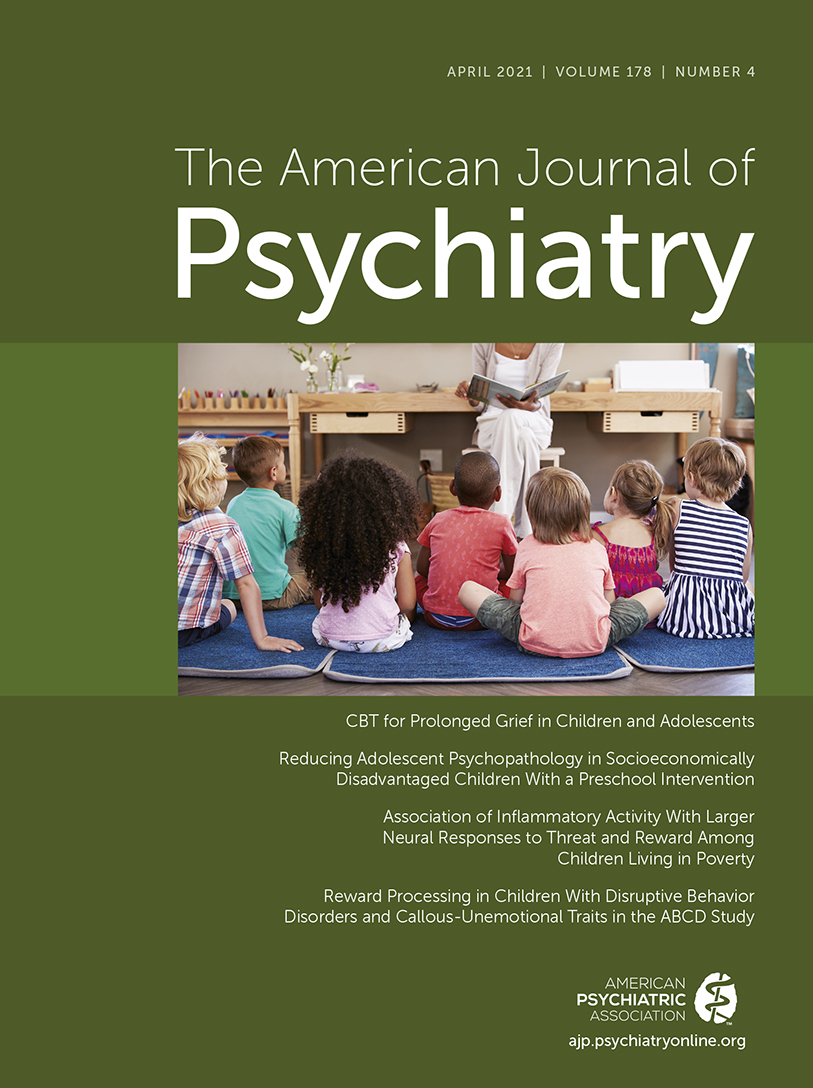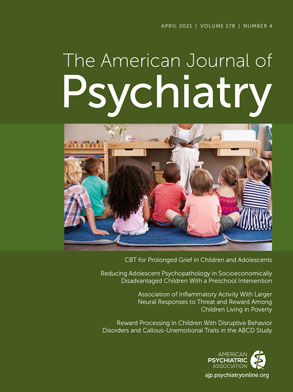There are three urgent and indeed great problems that we face not only in the United States of America, but all over the world today. That is the problem of racism, the problem of poverty, and the problem of war.
—Martin Luther King
The prescient words of Martin Luther King ring true today, and each of the “great problems” he cites is a major source of early-life trauma. In 2018, 38 million people in the United States lived in poverty, defined as a family of four with an annual income of less than $25,700. That year, 16.2% of children (11.9 million), or one in six, lived in poverty (
1). Because of the COVID-19 pandemic, poverty will rise to levels unseen in a decade worldwide (
2). There is a vast body of evidence that poverty, as one form of childhood maltreatment, is associated with poor health outcomes and with increases in both major medical and psychiatric disorders. These data include large macro studies that have documented evidence of causal relationships between poverty and mood and anxiety disorders—primarily major depression and generalized anxiety disorder—and, not surprisingly, suicide rates. These studies also have reliably documented reductions in psychiatric morbidity associated with interventions to reduce poverty (
3).
It is in this context, and that of the literature on the particularly egregious effects of poverty on children (
4), that Miller and colleagues conducted their seminal study published in this issue of the
Journal (
5). Similar to many studies that represent incremental advances, this study is characterized by its straightforward experimental design and exciting and somewhat unexpected findings. Fundamentally, this investigation sought to test the authors’ “neuroimmune network” hypothesis, which posits an important role for chronic early-life stress in increasing peripheral inflammation, which acts on brain pathways that mediate threat and reward processing. The persistent increase in “cross-talk” between the peripheral inflammatory network and the CNS is believed to increase vulnerability to mood and other psychiatric disorders.
The authors used standard criteria to classify a sample of 277 eighth graders in Chicago (ages 13–14, all English speaking and in good health) by socioeconomic status (poverty, low-income, middle income, and higher income). Morning blood samples were obtained for measurement of five inflammatory markers: C-reactive protein, tumor necrosis factor-alpha, and interleukin 6, 8, and 10. After log transformation, a composite “inflammatory” index was calculated. In addition, standardized functional MRI (fMRI) paradigms to study response to threat (amygdala reactivity to angry faces) and reward (ventral striatal reactivity to winning money) were completed in 207 and 172 study subjects, respectively. Children living in poverty showed higher composite inflammatory scores compared with their mid-income peers and slightly higher scores compared with their higher-income peers. In keeping with the authors’ hypothesis, amygdala responsivity to threat was positively correlated with inflammation composite scores among children living in poverty. Surprisingly, so was striatal reward reactivity.
These findings are of considerable interest and merit comment and discussion. The results are largely congruent with previous observations on the neurobiological and clinical effects of poverty and fit well with the toxic stress model described by McEwen and McEwen (
6), a derivative of the stress-diathesis model of depression. Toxic stress is defined as the frequent or chronic activation of biological stress systems, which would include neuroendocrine (e.g., the hypothalamic-pituitary-adrenal [HPA] axis) and immune pathways, resulting in an overload that disrupts homeostasis. Indeed, many studies, including our own (
7), have demonstrated a persistent increase in inflammatory markers in victims of child abuse and neglect; these data have been comprehensively reviewed by Danese and Lewis (
8). Moreover, a previous study utilizing fMRI (
9) revealed the profound effects of childhood poverty and chronic stress on ventrolateral and dorsolateral prefrontal cortex activity and amygdala responses to stress in young adults. It is also important to note the counterintuitive observation of a positive correlation between striatal reward activity and inflammation. Perhaps positron emission tomography studies utilizing radioligands such as the translocator protein to directly assess CNS inflammation would shed light on this apparent conundrum (
10).
As expected, studies such as this one raise a number of questions, both about the study itself and about future directions. A large number of factors are known to contribute to both inflammatory state and the responsivity of the circuits assessed by fMRI in this study, as well as to disease vulnerabilities. These include, first and foremost, assessment of the various categories of childhood maltreatment, such as those assessed in the often utilized Childhood Trauma Questionnaire or a scale designed specifically for children, such as the Traumatic Events Screening Inventory. Such dimensional scales quantitatively assess for sexual, physical, and emotional abuse and neglect and would have been a valuable tool in Miller and colleagues’ study.
Relevant to this study is the report on rates of child maltreatment in Austin, Texas, which closely follow the maps of poverty, lack of educational opportunity, and community violence (
11). In addition to these social determinants of health, multiple biological factors are also known to contribute to disease vulnerability after childhood maltreatment and to modulate, directly or indirectly, immune function and both stress and reward responsivity. These include, notably, genetic variations and epigenetics mechanisms, as well as HPA axis and sympathetic nervous system activity (
12–
14). Even in a relatively small sample, polygenic risk scores can be informative, and the genome-wide association studies of both posttraumatic stress disorder and major depressive disorder have grown substantially in size. A number of other critical factors are noteworthy. The role of air pollution, both in depression risk and the inflammatory response, is worth considering (
15), especially in view of impoverished urban areas often having the highest levels of pollution.
The use of a composite inflammatory index is novel and of considerable interest. At first glance it may be viewed as analogous to polygenic risk scores, now viewed as a major advance relative to the older candidate gene approach. However, careful scrutiny raises questions about this approach. The authors calculated a mean of the markers to achieve an index. It is unclear why the investigators only measured five of the many inflammatory markers available. In our study of never-treated depressed patients, we measured 23 pro- and anti-inflammatory cytokines (
16). Inclusion of this larger panel would likely have been more informative. Putting that concern aside, considering each of their inflammatory markers of equal weight in calculating the cumulative index is certainly not yet well substantiated.
What appears clear is that, not surprisingly, a myriad of factors contribute to the effects of childhood maltreatment—and poverty more specifically—on disease vulnerability. In the face of such a multifactorial model of causality, many would agree that it would be prudent to steer away from classic statistical modeling approaches in which a relatively small number of variables of interest are measured but instead to employ machine learning with many potential predictive variables. In order to accomplish this goal, a very large number of very finely phenotyped subjects would need to be studied, not cross-sectionally, but longitudinally (
17). Such an approach, although surely difficult to fund via the usual extramural mechanisms, may well yield valuable information about disease vulnerability, resilience, and, perhaps most important, response to interventions. Finally, we remain largely ignorant as to whether intervention, proximal to early-life trauma or even later in life, and what types of intervention, can prevent or reverse the inflammatory, neurobiological, and clinical consequences of poverty and other forms of childhood maltreatment.

